|
davidferriz
|
 |
« on: October 18, 2016, 06:54:56 AM » |
|
Hi! King Lucas is an adventure and platform game where the user impersonates a brave knight to accept King Lucas' requests and confront different non linear quests in a castle of more than 1.000 rooms. The castle, full of dangers, changes its shape and size at each new search. In order to achieve his goals the user will be able to use various spells, weapons and magic items which will help him in his trail. In a 2.5D style and featuring procedural music, the game will also include an online multiplayer mode where several knights will compete for the same goal. After almost 4 years of development, we’re ready to say that the launching of our most ambitious indie game is really, really close. Today we release several news about it. On one hand, you can already sign up to the distribution list of King Lucas [ https://www.kinglucas.com/]. If you’re an early-bird who doesn’t like to miss a single discount, get on board in order to get notified and enjoy a discount. Do you work in media and want to be one of the first ones in testing King Lucas for free? You can also sign up there! On the other hand, we’re launching the devblog of King Lucas to open another communication channel to keep you informed of any news about the final stage of development and the final release. The team members are going to regularly publish some interesting as well as curious posts to share with you technical details and anecdotes regarding different aspects of the game (design, art, music, programming…). Moreover, we would like this one to be bidirectional and we’re absolutely open to your questions, comments and random thoughts. And We're also very excited to show you the ultimate trailer for King Lucas! Trailer: Screenshots:      Twitter: https://twitter.com/devilishgamesFacebook: https://www.facebook.com/kinglucasgame/Steam group: http://steamcommunity.com/groups/devilishgames |
|
|
|
« Last Edit: December 01, 2016, 06:03:27 AM by davidferriz »
|
 Logged
Logged
|
David Ferriz, Game Designer and Graphic Artist at DevilishGames.
|
|
|
|
davidferriz
|
 |
« Reply #1 on: October 18, 2016, 07:16:22 AM » |
|
Devblog #1 - The birth of a king
For those who don’t know us yet, DevilishGames is an spanish company with more than 18 years of experience in the game development industry. In this time we’ve worked with a lot of technologies and different business models and we’ve published more than 150 games for several platforms but, being honest, I think we’ve never released a game that “gamers” may consider a “big success”. The truth is that we’ve entertained more than 100 million people with our games and we’ve been able to get our bills paid at the end of the month but it’s also true that, if we close the company tomorrow, people would probably recall us as “those who made Flash games” or “those who made advergaming for food and toys brands”. Don’t misunderstand me, I’m very proud of we have achieved with our small indie games at DevilishGames and with advergames that we have released through our advertising agency, Spherical Pixel, but it’s also true that most of our team members have felt gutted about not having released a bigger project.
I perfectly remember the day when this game came to life. It was April of 2012 and my associate, Enrique, and me were travelling to Valencia to install a serious game in an event. On the route, Enrique told me he and his wife were planning to be parents soon (I got it as a joke but 9 months after I realized he was completely serious). In theory we were only attending the event in order to give technical support just in case any problem but it seemed our client didn’t understand what “technical support” meant and we finally ended up being hostesses for hundreds of schoolboys and schoolgirls who wanted to play the game. Even though it was a funny experience it had nothing to do with what we dreamt when we decided to create games. That made us think a lot in the journey back to our hometown so, in order to cheer ourselves up, we started to imagine how the game we’d really like to make would look like. I don’t know if it was because of our conversation about parenthood but both agreed that we wanted to develop a game that would make our future kids feel something akin to what we felt when we played with our 8 bit computers and consoles. Ideas started to flow and the one hour and a half trip seemed really shorter. I arrived home absolutely excited with a bunch of ideas that won’t stop flitting around in my head; I barely slept that night.
After that motivational brainstorming, we came back to our day to day and kept on centered on advergames and serious games for our clients but the idea was still there and, in our spare time, we begun to cook it on a slow heat until in January of 2013 finally we decided to start the development fo the game, a game we named King Lucas to celebrate the birth of Lucas, the new born Enrique’s son. From that moment we embarked on an adventure that had lasted much more than expected and we will relate in next posts of this devlog.
|
|
|
|
|
 Logged
Logged
|
David Ferriz, Game Designer and Graphic Artist at DevilishGames.
|
|
|
|
davidferriz
|
 |
« Reply #2 on: October 27, 2016, 02:39:41 AM » |
|
Hi guys, King Lucas' page is available in Steam so that you can already add it to your wishlist! http://store.steampowered.com/app/391600Regards |
|
|
|
|
 Logged
Logged
|
David Ferriz, Game Designer and Graphic Artist at DevilishGames.
|
|
|
|
davidferriz
|
 |
« Reply #3 on: November 02, 2016, 08:37:09 AM » |
|
Devblog #2 - An old fashioned gameIn the previous post of King Lucas devblog I explained how the former idea was born but I didn’t tell you how it became what it is today. In this new post I’m going to try to give you some details about the game design process. The influencesMe and my associate spent our childhood playing 8 bit games. Enrique had a 286 where he used to play Goody, Fury of the Furries and Prince of Persia (the real one, that still hadn’t got “bullet time” and those kind of things). In my case, my first contact with games was the Master System II and my favourite ones were platformers. I remember wasting hours and hours playing Alex Kidd in Miracle World, Castle of Illusion, Asterix, The New Zealand Story, Alien 3 or Sonic as well as I had really good times playing games of some other genres such as Shadow of the Beast or Gaunlet and in other consoles like Super Mario World 3 in NES.  The former idea The former ideaEnrique and me agreed we wanted to make a platformer like “those from the good old times”. This means we wanted something direct and simple for the user, something that wouldn’t need a 10 minutes tutorial to start playing and no more buttons than the Master System II or NES controllers had. The classics that inspired us offered a short game experience (from 2 up to 3 hours) and, although we wanted to deliver that 8 bit experience, we didn’t want to limit ourselves to carbon copy those games and miss the possibilities of the actual technology, so we decided to create an experience long enough to fulfill the expectations of nowadays players, because launching a 3 hours game and succeed is something that only some privileged get, like Limbo. In order to reach this goal we designed a single player mode that offers between 6 and 12 playing game as well as a online multi-player mode that extends the product life.  A changing castle A changing castleIn Alex Kidd, Castle of Illusion or Prince of Persia the goal was to rescue somebody, usually a princess. We decided to keep that schema, but with a non-linear game narrative in which the player can choose hundreds of different routes to get to the end (that’s why the playing time of King Lucas has such a wide range). Some roguelike or metroidvania games generate levels and mazes in a completely procedural way, but we didn’t want to leave the level design in the hands of an algorithm. We’ve always thought that each tile, each jump, each secret passage and each danger must be strategically located so we chose to hand design hundreds of different rooms to then combine them so together they build a different massive castle for each quest and for each player.  The game design document The game design documentIf your reading this devlog you may probably already know that a design document is the bible where all the details of the game to be developed are compiled in order to be a reference for the whole team through the process. To make this document is usually a laborious job but it really save a lot of time in the development. Starting from the point of creating a platformer with classical mechanics set in a large castle that changes in each play, in early 2013 we began to write the game design document without having very clear which platform the game was going to be oriented for. We had a lot of experience developing Flash and mobile games so initially started to make prototypes for mobile devices, web browsers and Facebook with a free 2 play model in mind, like Candy Crush, but as soon as we showed the game in some events and see the reaction of the users we realized that we hadn’t a mobile game; it deserved to be played with a controller or a keyboard! Moreover, I’ve never been a free 2 play advocate because I think that if you fail in tuning the model you may end up screwing a good game and even getting very low profitability. While writing the design document I was worried about using too much time thinking of monetization instead of dedicating these efforts to think about how to make the users have fun so, even though discarding the work done up to that date was a hard decision, finally we forgot the tactile control, the free 2 play model and we focused on working to launch King Lucas for PC, Mac and Linux in Steam (and maybe consoles later). As you probably guess, dismiss the design with half development advanced is not the ideal way of working and it delayed our launch but it’s also true that, now when the game is almost finished, I think it was the best of the choices because if we had been limited by these factors we wouldn’t have been able to make the game that we really wanted to. The gameplayAfter showing the trailer and the beta version of the game in several festivals we received a very valuable feedback and that helped us much to improve the game but we are also aware that, even with those improvements, maybe some players won’t find in it what they look for in a game. From the very beginning a lot of users have compared King Lucas to Rogue Legacy and other action games; of course that’s a compliment for us but that has never been our goal. In King Lucas you can fight a good bunch of enemies, final bosses and use a lot of weapons and shields, but fights are not the main part of the game and, being honest, there’s no frenetic action here nor hundreds of enemies and heavy shooting on screen. In fact King Lucas is a platformer where the important thing is to get yourself oriented in its massive castles and for it we created two significant items: the compass (that points to your goal) and the crystal ball (that tells you how many rooms there are between you and it). These items, together with the keys to open doors, are the key advantages in order to not wander aimlessly through the castle and overcome the quests, independently of the power and endurance of your chosen weapons (that also help, but not so much). To complete the inventory we included the classical health and invincibility potions that no classical platformer should lack.  The outcome The outcomeAfter almost 4 years of development, some weeks ago we could make the first formal round of beta testing which gave us useful insights in order to balance the difficult of the game as well as the prices of weapons and other items. Right after playing for 30 hours that beta on myself I suddenly felt a huge need of revisiting the classics that inspired us and that, in some cases, I hadn’t played for more than 20 years. It was after some plays with my old Master System when I understood how much weight those games had carried and how, almost in an unconscious way, we had recreated so many references and homages to them inside King Lucas. Some days ago my father -who’s always concerned about my company but know nothing about games- asked whether King Lucas was “the kind of game that sells today“. Honestly, this question puzzled me and I did my best not to reply because the answer wouldn’t have probably reassured him. On one hand, the honest answer would have been no, King Lucas is not the game somebody would create actually in order to make money but, on the other hand, I’m sure that if we reach the players who grew up playing Alex Kidd, Wonder Boy or Castle of Illusion and we achieve to transport them to their childhood for a few hours at least we will have a chance to cover the investment made in these 4 years of development. 
|
|
|
|
|
 Logged
Logged
|
David Ferriz, Game Designer and Graphic Artist at DevilishGames.
|
|
|
|
davidferriz
|
 |
« Reply #4 on: November 11, 2016, 05:46:29 AM » |
|
Devblog #3 - The castle of 1.000 levels1.000 rooms is a round number, it sounds nice and that’s why when we launched the Greenlight campaign press wrote headlines such as “The game of the 1.000 levels”. 1.000 rooms is a great number for promotion but in fact it’s not real, King Lucas’ castle is made of more than 1.000 rooms, exactly 1.223. In previous posts about King Lucas I told you that we discarded procedural design for the levels so, together with my partner Laura Suárez, I was in charge of designing them one by one, drawing each single tile, gauging each jump and placing each danger so that the player finds them in the right place. To design such a large number of rooms may seem a heavy task (and it is) but thanks to that work we can empathize with the user at every single room in order to deliver a good bunch of details, references and thrilling or chilling moments that an algorithm wouldn’t have been able to design procedurally.. Defining the rulesEven though the level design is not procedural, the disposition of them inside the castle grid is done (almost) randomly, so when we designed them we had to define some basic rules so all of them could fit together: - They’re all the same size (40×30 tiles). - They all have 4 doors to enter/exit. - When a player gets inside a room he has to be able to reach at least one of the other doors.  In addition to the rules for connecting rooms, we also had to take into account the speed of the hero as well as the height and length of his jumps, because in every platformer is very important for the player to feel that any tile is there for one reason (Super Mario games are a good example of this). For this we designed several prototypes and tested with different users until we found the ideal speed and jump for an optimal control of the character (3 tiles high and 4 tiles long). We know the parameters of the character’s movement are far away from the frenetic canons that actual platformers set (that let the player move faster, double and triple jump or even bounce on the walls), but this is completely premeditated because we always had clear that the character moves had to be as close to the 8 bit classics as possible.  The tools The toolsFacing the challenge of designing more than 1.000 rooms was complicated, we needed a tool to design them as easily as possible as well as design them based on tiles so the game wouldn’t weight several Gb’s (and get minimum loading times). With these factor in mind we chose Tiled (Tiled Map Editor), a free tool great for 2D level design. Thanks to Tiled we could design rooms at a pace of 5 to 10 rooms for day, what meant designing all the rooms in 5 months working full time. Although the game was going to be completely 2D, when we experimented with the possibilities of Unity we decided to extrude the platform tiles to get some depth and reach a 2.5D style. This, together with the dynamic lights, gives a more modern touch to the graphics of the game. The pieces of the puzzleThe elements we used to build the rooms of the castle are absolutely inspired by the 8 bit classics and, as you can imagine, it won’t lack lava pits, spikes, ladders, sliding platforms, water, barrels, secret passages, enemies and NPC’s. When Laura and me began the design of the rooms, programmers couldn’t work full time to this game (they were working on several advergames for external clients), so most of those elements weren’t designed yet and we couldn’t used them in the rooms. Along the first weeks we created aproximately 100 rooms that only had spikes and ladders, something quite boring but it was great to get used to Tiled and, by the way, create some quieter rooms that add some relax moments to the narrative of the game. The programmers implemented the rest of the game elements little by little and each time they delivered a new one we squeezed it to the maximum and this is why you’ll find some rooms full of slugs, or spiders… probably it will be because we had that new element the week when we designed that room and we were looking forward to use it! That’s all! The developers finish all the elements when we had about 700 rooms so we still had time to create some hundreds of rooms that included a more balanced number of different elements and this way get a more homogeneus castle.  The inspiration The inspirationTo design levels is funny and the proof is that many people pays for it in games like Little Big Planet or Mario Maker, but it is also true that when you spend 8 hours a day doing it it’s easy to run out of ideas. It’s because of this why we found inspiration in our daily life and you’ll find in King Lucas’ castle rooms to celebrate moments like the day we designed the 700th. room, affection blinks to my partner Laura, a lot of hidden messages, christmas trees or even the castle of my hometown (Villena), where I usually go to walk with my dog, Willy (that is a character in the game too).  When everything fits When everything fitsAs I’ve said in other posts, the main income source of DevilishGames is the advergames we make through our advertising agency, Spherical Pixel, and indie projects such as King Lucas are an undercurrent task for the team members who are not working in other more inmediate projects. Usually, our development team is busier than our art directors and, in some way, this fact has conditioned the development of King Lucas because for a long time we have had to design and test rooms alone without being able to visualize the whole castle, the whole game. It may sound incredible but in almost 4 years fo development we only have been able to test a complete beta version 4 or 5 months ago, when we finally could check that all the rooms fit magically as we imagined (even better). No doubt this testing was a tipping point that led us to change our company strategy and invest more resources in King Lucas instead of looking for external clients as we do usually. Whether we are right or wrong only time and Steam players will say! 
|
|
|
|
|
 Logged
Logged
|
David Ferriz, Game Designer and Graphic Artist at DevilishGames.
|
|
|
|
Pixel Noise
|
 |
« Reply #5 on: November 11, 2016, 06:07:25 AM » |
|
Wow the attention to detail in the room design, the sheer volume of it, and that gif that shows you panning out and how all the rooms connect is pretty incredible!
|
|
|
|
|
 Logged
Logged
|
|
|
|
|
davidferriz
|
 |
« Reply #6 on: November 18, 2016, 02:30:03 AM » |
|
Hi friends, Today, finally, we can announce the release date: Dec. 1st. Here you got the new trailer and link to it in Steam ( http://store.steampowered.com/app/391600). Add it to your wishlist! Trailer: Regards, |
|
|
|
|
 Logged
Logged
|
David Ferriz, Game Designer and Graphic Artist at DevilishGames.
|
|
|
|
Hao
|
 |
« Reply #7 on: November 18, 2016, 06:29:15 AM » |
|
Added! Saw this on Facebook. Congratulations on your release -- hoping to play this soon!  Multiplayer will be available on launch? |
|
|
|
|
 Logged
Logged
|
|
|
|
|
davidferriz
|
 |
« Reply #8 on: November 21, 2016, 02:01:41 AM » |
|
Thanks! Yes, online multiplayer will be available on launch :-)
|
|
|
|
|
 Logged
Logged
|
David Ferriz, Game Designer and Graphic Artist at DevilishGames.
|
|
|
|
davidferriz
|
 |
« Reply #9 on: November 25, 2016, 04:52:28 AM » |
|
Devblog #4: Getting a retro look without pixel artIn previous posts of King Lucas devblog I pointed out our main inspiration sources for game design were 8 bit games like Alex Kidd in Miracle World, Castle of illusion or Asterix, but I still haven’t talked about the graphics of the game so in this post I’m going to try to explain how we got that special look of King Lucas. There’s a lot of people who think a retro game is synonimous with pixel art. This is a very usual association I don’t agree much because I don’t think that size of the pixels or the number of colours define how much retro a game is. I remember when my parents bought my first console, a Master system II, and back then I was a child who had no idea about what a pixel was nor how a game graphics were done, for me those characters jumping on screen were just magic. When I recall those games I don’t recall them pixelated, maybe because of the blur of my old tv, but I prefer thinking it was because I looked at them with the eyes of a child, eyes that used to let me immerse myself in a world full of colour and set my imagination free in a way that actual games can’t achieve. Don’t get me wrong, maybe this is not because of actual games but just because I don’t look at them with those eyes of a child. When I began working on King Lucas graphics I was sure I didn’t want to limit myself to make a game with pixel art and a 16 colours palette in order to get an 8 bits style, what I wanted was to feel King Lucas the same way I felt 8 bit games when I was a child, I mean, without limits of colours, size or resolution. The charactersEven though King Lucas may be defined as a metroidvania, our inspiration in terms of game design and art have been always quite far from titles as Castlevania or Metroid, because of this when I started designing characters for the game I never imagined them tall and stylized, in my mind they were shorty, cute and big headed like Alex Kidd or Wonder Boy. I had this so clear that most of the concepts were born at first intent, almost automatically. This is not very interesting for the making of, but we really didn’t have a big documentation stage, we didn’t do hundreds of sketches and we didn’t studied the market in order to find out which style was selling the best, I just drew the characters that were in my mind since I was a child, just as I remembered them.  The first character I designed was the hero and that was the main reference to design the rest of them together with my workmates Antonio and Lidia. In total, there are more than 50 characters in the game counting enemies, bosses and NPC’s, and all of them were created following the same process: first a pencil sketch and then a sliced vectorial version ready to animate. We used vectorial versions for long time but, at some point, we decided to give more depth to the scenes, making them become 2.5D in order to get a richer visual experience, so we also retouched the characters giving them some paintwork with the Wacom. This way we got more detail and volume, according to the new style of the scenes.  The scenes The scenesAs I explained in the post about level design, the rooms of the castle were tile based. We initially made a tileset with 4 different coloured rooms but in the first stages of testing some people told us it was a little bit monotone, so we looked for a solution to offer more graphic variety without drawing new tilesets because there was no additional time nor budget for it. We found it again in the oldies, in the 8 bit games where artists and programmers had to struggle with limited colour palettes to get visually rich games without increasing the weight of the game too much and, basically, that was what we did: we modified the palette of the existing tileset to get new shades in each quest. It seemed to work out because no tester has complained about this since then!  The overall The overallTo finish the integration of the character sprites into the 2.5D levels we took advantage of the Unity lights and shades features that gave more depth to the final result. We also modeled some objects completely in 3D such as barrels, doors, coffers or items, creating a link between the scene and the hero, who can interact with them. Anyway, we didn’t want the game to look very 3D so these details are quite subtle and you will appreciate them only if you take a close look.  To change the graphics look from 2D to 2.5D in the middle of the development had a huge impact on our timing and it gave quite extra work for programmers and artists but it also let us achieve stronger and more personal visuals, something different to most of the actual games. After 4 years working on this, it’s difficult to be objective but, being honest, when I tested the first complete beta of King Lucas, its graphics took me to that place in my mind where I keep my childhood memories of playing 8 bit games. Now I only hope that when we publish the game, lots of users born in the 70’s and the 80´s will also recall those feelings they got with their old games, but now in full HD, with millions of colours and without having to play characters drawn with massive pixels. King Lucas will be available on Steam in December 1st: http://store.steampowered.com/app/391600/
|
|
|
|
|
 Logged
Logged
|
David Ferriz, Game Designer and Graphic Artist at DevilishGames.
|
|
|
|
Enrik
|
 |
« Reply #10 on: November 25, 2016, 06:49:02 AM » |
|
Oh, I just discovered this game and I love it! I'll buy it next week for sure. Glad to see some good quality spanish game here!
|
|
|
|
|
 Logged
Logged
|
|
|
|
|
davidferriz
|
 |
« Reply #11 on: November 26, 2016, 11:40:30 AM » |
|
Thank you very much Enrik!
|
|
|
|
|
 Logged
Logged
|
David Ferriz, Game Designer and Graphic Artist at DevilishGames.
|
|
|
|
jandu
|
 |
« Reply #12 on: November 28, 2016, 03:09:29 AM » |
|
Only 3 days to launch!
Good luck Devilish Team!
|
|
|
|
|
 Logged
Logged
|
|
|
|
|
davidferriz
|
 |
« Reply #13 on: December 01, 2016, 08:26:34 AM » |
|
Put your swords up in the air, King Lucas is here!It's been almost 4 years of hard work but the wait is over! We have just released King Lucas in Steam and it's already available for everyone with a Windows PC, a Mac or a Linux computer. As you may know, King Lucas is a metroidvania game with 2.5D graphics, single and online multiplayer modes and classic game mechanics for the delight of platform and adventure games lovers as well as for those who didn't live the 80's; this is an opportunity for anyone to taste that classic feeling with the graphics and sound quality of today.  King Lucas is available for $12.99 but, for a limited time, we are offering an early-bird 25% discount King Lucas is available for $12.99 but, for a limited time, we are offering an early-bird 25% discount. Hurry up before it's over! Now King Lucas is your game and we hope you enjoy it as much as we enjoyed developing it. Moreover, if you're one of those curious cats who enjoy looking behind the scenes, we keep on publishing interesting post-morten info in the game devblog and we'll keep on doing it for several weeks. Steam page: http://store.steampowered.com/app/391600/
|
|
|
|
|
 Logged
Logged
|
David Ferriz, Game Designer and Graphic Artist at DevilishGames.
|
|
|
|
davidferriz
|
 |
« Reply #14 on: December 16, 2016, 03:22:05 AM » |
|
Devblog #5: How to animate a king who has lost his daugthersAntonio Pastor, Art Director, talks about the animation work in King Lucas. This doesn’t mean I’m going to do therapy with the King laying down in a couch and I listening to his problems, I’m obviously going to talk about the animate work made for King Lucas through these years. One of the most important factors for a game to be satisfying for the user is to see every single character perfectly animated and we wanted that for King Lucas. In order to be appealing for the users we had to make really cool frames and some naive movements to fit with the cuteness of the characters. In a first stage we had to focus on the basic movements the main character as well as the enemies need to have so, for this, we needed animations for breathing (when the character stands still), walking, jumping, attacking, receiving hit and dying.   Once we had this, we needed to think on the different situations we could find in the game so we could add those animations to the basic ones. For example, if you jump, it would be fine to see the hero feeling the impact when he falls to the ground and when the hero goes upstairs he needs to move like he’s doing that… sooner than later you find out you need much more animations than the basic ones. Since the game was initially oriented to mobile devices, as my workmate David Ferriz told in the “an old fashioned game” ( https://www.devilishgames.com/en/2016/11/02/an-old-fashioned-game/), the number of animations had to be limited and, for example, any single enemy had to die the same way, or maybe the hero only could have two kind of hits. Furthermore, animations couldn’t have too many frames so that when we exported them to the tileset the weight of the game wouldn’t increase much (because, as I’ve said, it was going to be played in mobile devices and social networks). Later, as we switched to Steam we could think big. Then we could dig deeper and now King Lucas have 416 animations counting the ones of the hero, enemies, king, princesses, villagers, the witch, the blacksmith, bosses and some others I’m probably forgetting… there were some that were discarded but only the hero -the one who has got more animations- do all these things (inhale): To breathe, to walk, to attack in seven different ways, to start a jump, to have a loop when he’s in the middle of a jump, to start a fall, to land a jump, to receive hits in three different ways, to swim, to go upstairs, to sheathe, to unsheathe, to die in seven different ways, to get bored in three different ways, to reach the limit of a platform, to stand in that limit, to find a princess and to talk (now you can exhale). Moreover, these movements get multiplied because they’re different depending on which side is the character moving to, left or right. The easy solution for this was to flip frames but, if so, the weapons would switch hands or, for example, an one-eyed character would be different depending on the direction of walk.  Fortunately in some cases it was easier, for example in the case of slimes that only needed three animations. Some secrets about animationsOne of the most tricky animations was the walk cycle of the hero; it’s a basic one and probably the most used in the game. In a first stage the character didn’t seem much heroic, it looked like he walked scared and his short legged look didn’t help much. We needed just the opposite, I mean, he’s serious about his quest, he knows what he’s doing and he’s supposed to be tough, so we changed how he walk to a more purposeful look.   We had the same issue when he attacked. In the first animation it looked like he was hitting the enemies with a toy sword. We decided to enrich it adding different kinds of hits and to use less frames so the animation was more raw. This way it looked he hit harder; sometimes you can give more with less frames. I was eager to start working on the different kinds of death of the main character. I know it sounds bad but it’s been the most funny part for me. Of course we had to keep things under control in every moment because we’re not talking about Mortal Kombat, this isn’t splatter and it needed to be still cute and bloodless (we made an early version with some blood though, but that was not the soul of King Lucas). For me, the most funny death is when you get bitten by a spider, let’s see which one is your favourite…   Regarding the animations of talk we knew that moving eyes and mouth would help to give feelings to the characters, feelings like pain (closing their eyes) or surprise (putting the O mouth), but we said we were going to comply with the classics so we decided it was enough with written texts and discarded these animations. Only and exceptionally we animated mouths and eyes of the bosses you’ll find along the game because this way we thought we were going to remark they were not average enemies and it will be way more spectacular. Of course I can’t help talking about our starry animations: when you do nothing… those animations that make you smile as you find out our hero is more human than you thought (and ahead of his time), but you’ll have to play to watch them!  Character evolution Character evolutionIn the beggining the characters were painted with plain colors and a simple palette because we thought that style fit with their big headed and shorty shapes. As we decided to change from mobile to Steam and we started to use 3D scenarios and light effects this meant everything was deeper so we decided to make the characters deeper too. First we considered 3D modelling for them but we preferred the 2.5D aspect, plain characters in a 3D stage, so we gave their volume with the shades of the first concept arts, using them as a skin over the yet done animations; it would be ok to say that we just changed their clothes. 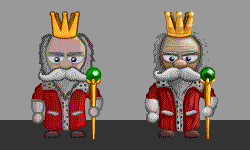 In classic games, when you went further in the game you usually found the same enemies in stronger versions and to put across it the developers sometimes just changed their colors. We liked to keep that idea so we did it but we added some shapeshift so the evolution is a little bit richer than those from the oldies. 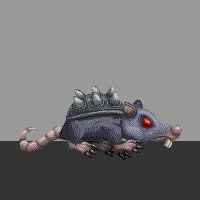 How you move your body? How you move your body?No, I’m not going to talk about dancing, obviously I’m talking about software we used to animate King Lucas. All of them were initially drawn and painted in Adobe Animate CC (formerly known as Flash). We cut them up and then we put each piece in its place to build the character again. 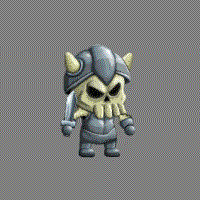 Next step was to prepare every movement needed. Once we had all of them, we exported to Spriter in order to have a more precise control of each part of the characters and be able to set any weapon or look change easily. The truth is that we had several problems when we exported the animations to Spriter because sometimes we got something like what you see in the image and, well, this is not we had in mind. We spent some time tuning animations until they were perfect. Fortunately, as time went by and with some updates of the software we were using this was simpler and simpler. Finally we incorporated them all to our Unity project, where all the programming work is made so that these animations fall into place and get all their meaning… but this is another story for a future post. 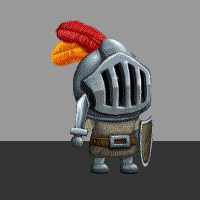 Remember King Lucas is already available in Steam! http://store.steampowered.com/app/391600/
|
|
|
|
|
 Logged
Logged
|
David Ferriz, Game Designer and Graphic Artist at DevilishGames.
|
|
|
|
davidferriz
|
 |
« Reply #15 on: January 17, 2017, 05:59:26 AM » |
|
Devblog #6: Music & sound FX in King LucasElío Ferrán goes through the process of creation of the soundtrack and music of King Lucas.  Back in 2013, the development of King Lucas was already gestating. Even though I was still no part of the team of DevilishGames, we were good friends. Until then, the music and sound for their games had been done with trackers (software that lets you create electronic music quite easily with the use of loops) and, sometimes, stock sounds and music. I had been making music in my spare time for many years, playing in bands, producing in my home studio and, since King Lucas was a bigger project, they agreed to let me propose something to without obligation. I had never composed music for games and was completely excited and motivated so I started working immediately, only with some early graphics as reference of what the game was going to be. This meant that, in my head, the only context I had was “a child-oriented game full of bobbleheads”. This was the first attempt: https://www.devilishgames.com/wp-content/uploads/2016/10/king-lucas.mp3Obviously, it didn’t work, today nobody could imagine King Lucas with this soundtrack. Shortly after I was officialy recruited as Marketing and PR Manager and, once in the team, because of my past experience as musician and my academic background in Cinematography, I also took control of the sound design, music and narrative of the games to come. Because of other projects, the development of King Lucas extended time enough for me to better understand the market, as well as to immerse myself into the referents and the style of King Lucas. No doubt it was a more serious game than I had thought months before. One must understand that it’s a game for children, of course, but it’s also for adults who enjoyed the games from the 80’s which King Lucas pay homage to so we had to satisfy their expectations, their likes, and they are not children anymore. This game had to be balanced between the childish and the serious, the comical and the epical, and the music had to follow the decision of making something retro styled without depending on 8/16 bits. Then, electronic music was discarded, we wanted something more cinematic, more orchestral. It was time to compose, the problem was that I had no previous experience in this kind of music, I use to write music with a guitar, but… I like challenges! At that time I was also involved in a rock project and, writing for it I found a phrase, not much more than a simple riff of a few notes, that I felt it had something that could become interesting if I were able to drive it into other places. Here you can listen to the main leit motif of the soundtrack of King Lucas, played with an electric guitar as it was originally born (fine tune your ears, it sounds below of the solo voice): https://www.devilishgames.com/wp-content/uploads/2016/10/Origen-King-Lucas.mp3This phrase was later played by a violin and backed by orchestral strings, all of them played with midi. Then the next step was to write a good set of arrangements in order to get a complete theme that could be later varied and extended to compose the in-game, incidental, menus music, etc… in a coherent way. You can see, for example, that the music of several menus is based in the main phrase, but played with a clavichord instead of strings. Finally, this was the result from where each and every little clip of music in the game come. You’ll hear the main phrase coming in at 49″. https://www.devilishgames.com/wp-content/uploads/2016/10/King-Lucas-offgame_completa_con_cola.mp3For the in-game there was another challenge: we couldn’t afford to record hours and hours of music for all the hours a gameplay can last and we didn’t wanted it to sound repetitive neither. The solution was the on-the-fly sequencing. We recorded a finite number of harmonic clips, and the programming team developed a system which, each time a new room is configured, chooses several of them and mixes them live and randomly for that specific room. It’s like having a virtual disc jockey on the background. This system made the music procedural, what gave us virtually infinite tracks with a very limited number of clips. Of course this is the short explanation because, in fact, the mixdown is not absolutly random; there are some rules such as the probability of triggering music is not the same as the probability of leaving just an ambience sound, avoiding this way the saturation of the user’s ears. Furthermore, there are some clips that can’t be mixed down together, those with percussion, for example. Sound designIn order to put sound to every action in King Lucas, the easiest way would have been to buy sounds from stock libraries. We considered this option because they’re high quality clips and not very expensive nowadays. However, these sounds didn’t fit in the style a game which is half way between the cartoon and a more serious style because they have, in fact, too much quality, they are too much realistic. We then decided to use foley to get what we exactly wanted. As you probably may know, foley is the technic of reproducing real sounds in a recording studio; for example, punches you can hear in movies are not real punches but, usually, a steak hitting a solid wood table. In real world punches don’t sound as you hear them in the movies… nor the gunshots, nor most of the things you hear. In the real world your ears work together with your brain to filter the sounds so you hear louder the most relevant ones, you don’t hear everything in the same level, otherwise it would be unbearable, but in an audiovisual the actions must be perceived, they don’t have to be realistic, they must seem it, they have to be plausible. This decision let us keep all the sounds in King Lucas under control. It was a really funny adventure, besides an incredibly creative process. We had to imagine how an slime that doesn’t exist sounds when it is cut in two, imagine how could we make a similar sound and process it until we reached the optimal result. We could make the sound of coins we wanted with some bolts over a trophy we received some time ago (we didn’t like how real coins sounded), the sound of swords we were looking for with forks and some reverb, viscous sounds for some creatures fulfilling our mouth with custard and gasping (we stained the mic and our clothing)… and the same for voices and moans. I would like to know what people of the offices next door thought the day we recorded voices and screams!  Problems? Yes, of course, our office is not a recording studio so it is not acoustically isolated, there’s AC noise, fans inside every computer and… traffic outside. We had to wait for the traffic light down the street gave us a break to start each recording. The microphone we used was a condenser microphone, very sensitive to low level noise, but if you are careful enough you can find the adequate conditions and dive into this technique to record your own sound effects. Remember King Lucas is available in Steam! http://store.steampowered.com/app/391600/
|
|
|
|
|
 Logged
Logged
|
David Ferriz, Game Designer and Graphic Artist at DevilishGames.
|
|
|
|
Dubbelrum
|
 |
« Reply #16 on: January 17, 2017, 06:27:06 AM » |
|
I might be mistaken, but I think I've seen this game like years ago somewhere (Unity forums maybe). Anyway, it's really nice to see you guys completed the game! Gongrats! Wish you good sales. I'll pick it up for sure  |
|
|
|
|
 Logged
Logged
|
|
|
|
|
jctwood
|
 |
« Reply #17 on: January 17, 2017, 06:36:11 AM » |
|
I absolutely love the tile work in this game!
|
|
|
|
|
 Logged
Logged
|
|
|
|
|
davidferriz
|
 |
« Reply #18 on: January 17, 2017, 09:29:02 AM » |
|
Thanks @jctwood and @Dubbelrum!
|
|
|
|
|
 Logged
Logged
|
David Ferriz, Game Designer and Graphic Artist at DevilishGames.
|
|
|
|
davidferriz
|
 |
« Reply #19 on: February 01, 2017, 03:47:02 AM » |
|
Devblog #7: Script and emergent narrative in King LucasElío Ferrán explains the narrative and non-linear dialogue system of King Lucas. Time before working in the game industry I was in the audiovisual sector; among other things, I studied Cinematography and worked on TV and, there, one of the first things one learns is how to structure a narrative: to create a conflict, to motivate your characters, to throw unsolved questions in order to intrigue the reader/viewer, etc. Mechanisms, in a nutshell, to drive the narrative and make the plot interesting and entertaining because, at last, that’s what we want: to entertain. These triggers work exactly in the same way for any kind of story, the problem arises when you jump from a linear media to a non-linear one, such a game, where there is a lot of elements that randomize everything and the user has freedom to alter his path through the story, more or less depending on the game. In King Lucas this is specially remarkable because, even though the level design is predesigned, the disposition of the rooms is random so the path of the user is completely free, thus running into the NPC’s in an order out of our control. In this post I’m going to explain how we overcame these challenges in order to make the narrative work out but, to start, we needed… The storyDon’t worry, no spoilers ;-) As some of my workmates have told in previous posts, King Lucas was born from the desire to homage some old games and a specific style so, when I began writing the script, the characters were already created, they were basic game design elements: one hero, some princesses to rescue, one king to introduce the hero to the missions, one blacksmith to sell weapons, some enemies, etc… the game design was quite clear and King Lucas would have been playable without any additional storyline but we were sure that adding a deeper narrative was going to add another dimension to the game. In order to get to the story behind King Lucas, first thing was to give personalities to the characters, give them some background that let them interact one each other in a meaningful way. You can’t imagine how two characters would talk to each other if you don’t know how they think. This way, for example, the blacksmith who was there only to sell weapons became Faust, a former blacksmith of the royal court and sexually ambiguous who decided he felt more confortable in the shadows of the castle of Sausan, or the skeletons that were there just because the game needed enemies became the former royal guard that, tired of so much laboral abuse, became republican rebels to the crown. Of course each personality was designed to cause frictions with the other characters’ personalities as well as to be hilarious, to build a comical tone just because it seemed funny to us. In fact, dialogues are peppered with out of context popular culture references that will make more than one user smile. Once the characters were defined, we had to make them interact. What they think of each other? What are they going to say? Do they hate each other, do they love, help each other? What do they know of each other? What do they find out? Are they going to betray anyone? Do they have a past in common or not? We defined this in what we called ‘the relationship matrix‘.  To focus the writing this way was absolutely intentional. We couldn’t forget that, since we were not going to be able to control the path of the user we needed a lot of additional information in addition to the main plot, many pieces of information which once shown, reveal the whole puzzle, the plot: an emergent narrative. When I explain the emergent narrative in King Lucas I like to do it this way: Imagine a group of people that have read a book and they’re in a room talking about it. You step into that room and listen to them, in no particular order you listen to fragments of the story that, in the beginning, make no sense for you but, as you get more details, you start joining the dots and the narrative emerges. You haven’t been told the story in a linear way, as the book is, but in the end you finally understand the plot. The relationship matrix was really usefull for this. There we had the main plot, the secret behind the story of King Lucas, who does reveal it to the hero (to the user), as well as a good bunch of secondary relationships. And now, how do we tell the story?Then, when we knew what we wanted to tell, we needed to find how to tell it in a coherent and comprehensive way despite the random trail of the user inside the castle. We could not allow, for example, an NPC #1 spoke about an NPC #2 if this last one haven’t appeared yet. We couldn’t let any NPC tell a piece of the story dependant upon another information still not told neither. In a nutshell, we shouldn’t disorientate users nor spoil the storyline. In order to this, we created several dialogue categories: - Conditional dialogues: pieces of the script that really drive the story, conditioned to previous pieces to be understood and, in turn, that trigger other conditions so other characters can tell more things.
- Filling dialogues: not very relevant information, tips about the game or just jokes which can be understood in themselves. When any character can’t reveal relevant information because it still hasn’t been triggered, he will talk using these dialogues.
- Operative dialogues: sometimes, some NPC’s need to give information related to the game, for example the Witch of Sausan who, apart from being a key part of the plot, needs to sell some items.
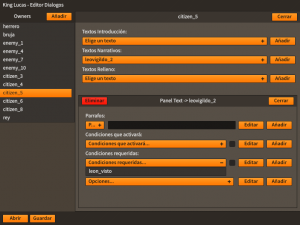 Once we designed this categorization, the programmers team developed a proprietary software where I could write the script, each dialogue with its unique id, and assign conditions (e.g: if the dialogue id=002 has been shown, then this other dialogue can be shown whenever possible). This way and without losing sight of the relationship matrix as well as taking into account the personality of each character to control the tone of their words, the script was finally written and, in the end, the game chooses what to show at each moment. Some secrets unveiledIt’s funny to include references you know not everybody is going to understand; it gives depth and shades to the game. Do you want to discover some of them? Here we go: At some point a character hastens to excuse for something the hero haven’t asked for and the hero answers: “ excusatio non petita, acusatio manifesta“. It’s latin, it means that if you put an excuse not required, you’re somehow confessing you’re guilty. The kingdom where King Lucas takes place is called Sausan. Sausan is a modification of Shawsha, the quechua (old language of the actual Peru) name for the city of Jauja. Jauja is also an imaginary country from the Middle Age where nobody needed to work to live, an imaginary country as Arcadia in the greek mythology. From Arcadia comes the actual term arcade. Join the dots
|
|
|
|
« Last Edit: February 01, 2017, 04:17:36 AM by davidferriz »
|
 Logged
Logged
|
David Ferriz, Game Designer and Graphic Artist at DevilishGames.
|
|
|
|
 Community
Community DevLogs
DevLogs King Lucas - [ Platformer / Metroivania ]
King Lucas - [ Platformer / Metroivania ] Community
Community DevLogs
DevLogs King Lucas - [ Platformer / Metroivania ]
King Lucas - [ Platformer / Metroivania ]
